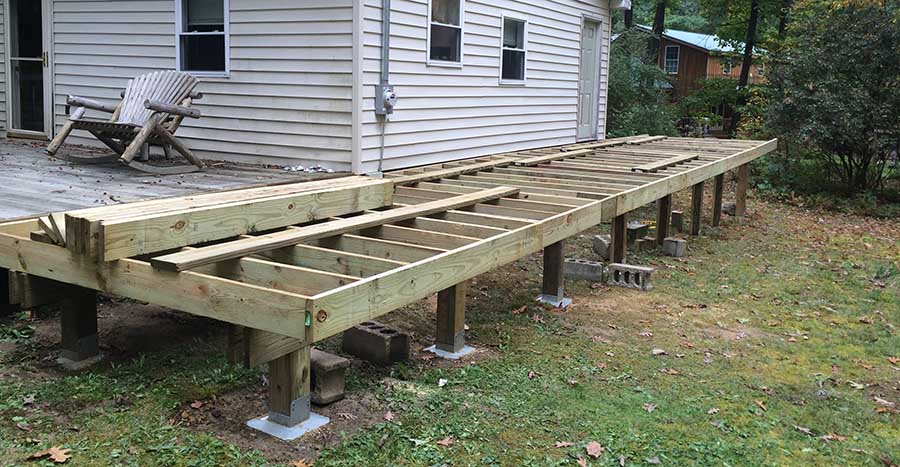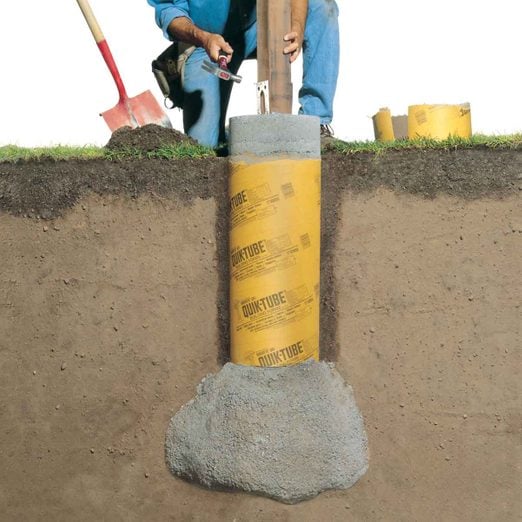Step-by-Step Deck Quality: Making Sure Stability with Properly Mounted Deck Footings
Choosing the Right Deck Footings for Stability and Toughness
When it involves building a deck, one of one of the most crucial decisions you will certainly make is picking the ideal footings for security and sturdiness. The durability and safety and security of your deck depend heavily on the sort of footings you pick, as they supply the necessary support and security to stand up to the test of time. With a myriad of choices available, it can be frustrating to establish which footings are best matched for your particular demands. In this discussion, we will explore the different sorts of deck footings, take into consideration the essential elements to consider when making a decision, and explore the benefits and drawbacks of different alternatives. By the end, you will have a more clear understanding of the options available and be better outfitted to make an informed decision for your deck task.
Kinds Of Deck Footings
There are numerous types of deck grounds that can be made use of, each offering unique advantages and factors to consider. One usual sort of ground is the concrete pier footing. These footings include a round hole filled with concrete, which offers a solid foundation for the deck messages. Concrete pier grounds are fairly very easy to mount and offer excellent security, making them a preferred choice for numerous deck tasks.
These grounds are installed by screwing them into the ground, which creates a protected foundation for the deck. They additionally allow for easy adjustment and progressing of the deck if required.
Additionally, some builders go with precast concrete footings. These footings are constructed from durable concrete and come in various shapes and sizes to suit different deck designs. Precast concrete grounds are practical to mount and offer a secure base for the deck framework.
Lastly, one more choice is the post-in-anchor footing system. This sort of ground includes driving a metal support right into the ground and affixing it to the deck blog post. It provides versatility in terms of placing the deck posts and is ideal for decks with lightweight frameworks.
When choosing the ideal sort of deck ground, it is necessary to consider aspects such as dirt conditions, deck lots, and local structure codes (Deck Footings). Consulting with a professional specialist or architectural engineer can aid guarantee the proper ground is chosen for a stable and risk-free deck
Factors to Consider When Choosing Grounds
When picking the ideal footings for a deck, it is vital to thoroughly take into consideration various aspects such as dirt problems, deck lots, and adherence to local building regulations. These aspects play a substantial role in ensuring the stability and toughness of the deck structure.
Among the key variables to consider is the soil problems. The sort of soil on which the deck will be developed figures out the type of grounds called for. Decks developed on loosened or sandy soils may require deeper grounds to supply ample support and prevent settling. On the various other hand, decks constructed on clay or extensive dirts may call for grounds that can fit the dirt's propensity to increase and contract.
An additional important variable is the deck lots. The weight of the deck, including the materials made use of and any prospective real-time lots such as furnishings or gatherings, should be considered when selecting footings. The footings have to be created to bear the weight of the deck and disperse it equally to avoid any kind of architectural problems or failings.
Last but not least, adherence to neighborhood building ordinance is vital. Building ordinance vary from area to area, and it is important to abide by the particular needs established by the neighborhood authorities. Deck Footings. These codes guarantee that the deck is developed securely and fulfills the needed standards for structural honesty and load-bearing ability
Concrete Grounds: Benefits And Drawbacks

Concrete grounds offer a number of advantages and downsides when made use of as the structure for a deck. On the favorable side, concrete footings supply excellent stability and longevity.
Another advantage of concrete footings is their convenience. They can be poured right into various sizes and shapes to fit different deck styles and arrangements. Concrete footings can be customized to fit the details needs and requirements of the deck framework.
However, there are also some downsides to utilizing concrete footings. One major downside is the cost and labor associated with their setup. Concrete footings need excavation and typically need the aid of heavy equipment. This can increase the total price of the deck task and might call for professional support.

Helical Piers Vs. Sonotubes: Which Is Much better?
In taking into consideration the structure choices for a deck, the comparison between helical piers and sonotubes is important in figuring out the remarkable selection. They are turned into the ground utilizing hydraulic equipment, supplying a sturdy and stable foundation for the deck.
When it involves stability and longevity, helical piers have the top hand. The helical plates on the piers create a strong hold with the dirt, changing or stopping any activity of the deck. This is especially advantageous in locations with unsteady or moving dirt conditions. Sonotubes, on the other hand, depend only on the concrete loading for stability, which might not supply the exact same degree of why not look here stamina and resistance.
In regards to installment, helical piers are fairly easier and faster to install compared to sonotubes. The hydraulic machinery utilized to turn the piers right into the ground ensures a quick and efficient process. Sonotubes, on the various other hand, call for digging holes and pouring concrete, which can be time-consuming and labor-intensive.
Additionally, helical piers are an even more flexible option. If needed, they can be made use of in numerous soil conditions and can be adjusted or strengthened. Sonotubes, on the other hand, might call for additional assistance, such as rebar, in particular soil problems or areas with high lots requirements.
Picking the Right Footings for Your Deck's Dimensions
For optimum architectural stability, it is important to meticulously pick the suitable footings that straighten with the dimensions of your deck. The dimensions of your deck, including its length, height, and width, play a substantial duty in establishing the kind and size of grounds required.
When selecting footings for your deck, it is essential to think about the load-bearing capacity of the soil. The weight of the deck, integrated with my explanation the weight of any type of furniture or people on it, applies a significant pressure on the grounds (Deck Footings). For that reason, it is vital to pick grounds that can adequately support this weight without shifting or sinking in time.
Larger decks with greater dimensions need bigger footings to supply adequate security and assistance. The shape of the footings, whether they are square or rounded, depends on the style and format of the deck.
Verdict
In final thought, picking the right deck footings is critical for guaranteeing stability and longevity. Factors such as the type of footings, the deck's measurements, and the pros and disadvantages of different options ought to be thought about.
These footings consist of a round hole filled up with concrete, which provides a strong structure for the deck posts. Concrete pier footings are reasonably very easy to set up and provide exceptional security, making them a prominent choice for lots of deck jobs.
Precast concrete grounds are practical to install and provide a secure base for the deck structure.
It provides versatility in terms of positioning the deck articles and is suitable for decks with lightweight frameworks.
Concrete visit the website footings offer a number of benefits and drawbacks when made use of as the structure for a deck.